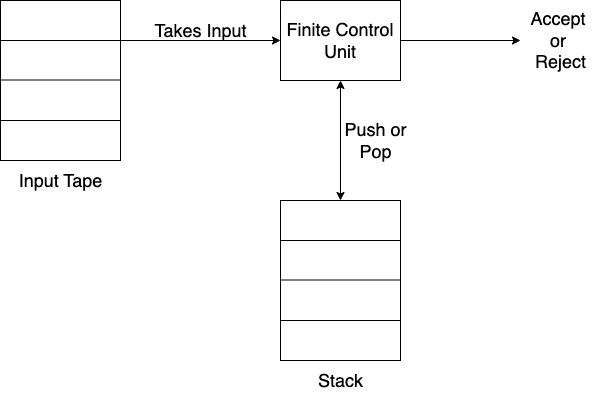Context Free Language
- CFL is a higher level language when compared to Regular Language.
- CFL is a language that can be generated by some Context Free Grammar and is a set of all languages that can be accepted by a Push-down Automata.
Context Free Grammar
Formal Definition: Defined by 4 tuples G = (V, T, P, S)
- V = Finite set of Variables or Non-Terminal Symbols
- T = Finite set of Terminal Symbols
- S = Start symbol
- P = Finite set pf Production rules
- Each production rule is represented as A→$\alpha$
- Where $\alpha$ is a string in ${V \cup T}^*$ and A $\in$ V
Example: For generating a language with equal number of 0s and 1s of the form $0^{n}1^{n}$. We will have the G = ({S, A}, {0, 1}, {S→0A1, A→0A1 | $\varepsilon$}, S)
- S→0A1 (using S→0A1)
- →00A11 (using A→0A1)
- →000A111 (using A→0A1)
- →000111 (using A→$\varepsilon$)
Push-down Automata
- A machine that generates Context Free Grammar
- It is more powerful than a Finite State Machine and also has more memory
- PDA = FSM + Stack
- Has 3 components:
- Input
- Finite Control Unit
- Stack

Formal Definition: Defined by 6 tuples P = (Q, $\Sigma$, $\Gamma$, $\delta$, s, A)
- Q = finite set of states
- $\Sigma$ = finite set of input alphabets
- $\Gamma$ = finite set of stack alphabets
- s = start state
- A = set of accepting states
- $\delta$ = Transition Function
Transition Function $\delta$
$\delta$ = $Q\times\Sigma \cup {\varepsilon}\times\Gamma \cup {\varepsilon}$ → $P(Q \times (\Gamma\cup{\varepsilon}))$
- $\delta(q, a, X)$ → $(p, \gamma)$
- $q$ is a state in $Q$, $a$ is either an input in $\Sigma$ or $a=\varepsilon$, $X$ is a Stack symbol that ios part of $\Gamma$
- $p$ is a new state and $\gamma$ is string of stack symbols that replaces $X$ at the top of the stack
- If $\gamma = \varepsilon$, then stack is popped
- If $\gamma = X$, then stack is unchanged
- If $\gamma = YZ$, then X is replaced by $Z$ and $Y$ is pushed into the stack

- $a$ = Input Symbol
- $b$ = Symbol on top of the stack which is pooped.
- If $b=\varepsilon$, then stack is neither read or popped.
- $c$ = The Symbol that is pushed onto the stack
- If $c=\varepsilon$, then nothing is pushed.
Example: Let’s construct a PDA that accepts the language $L = {0^n1^n | n\ge1}$

Closure Properties of CFL
Given two CFG $G_1 = (V_1, T, P_1, S_1)$ and $G_2 = (V_2, T, P_2, S_2)$ and assume that $V_1 \cap V_2 = \phi$. Let $L1$ and $L2$ be languages produced by $G1$ and $G2$ respectively.
- CFLs are closed under Union. $L_1 \cup L_2$ is a CFL.
- CFLs are closed under Concatenation. $L_1 . L_2$ is a CFL.
- CFLs are closed under Kleene star. If $L$ is a CFL $\implies L^*$ is a CFL.
- CFLs are not closed under Intersection
- CFLs are not closed under Complement
Additional Resources
- Textbooks
- Erickson, Jeff. Algorithms
- Sipser, Michael. Introduction to the Theory of Computation
- Chapter 2 - Context-Free Languages
- Sariel’s Lecture 7

